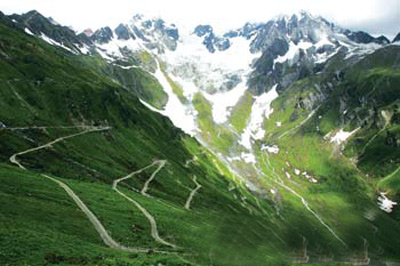| Tools: Save | Print | E-mail | Most Read |
| Road to Link Tibet's Last Roadless County |
| Adjust font size: |
Now that the world's highest railway connecting Tibet to the rest of China is in operation, the autonomous region plans to build a highway linking its "elusive lotus" in the Himalayas, say local officials. At Tibet's border with India, nestled among snow-capped mountains is the county of Medog, which is the last of the country's 2,100 counties to be connected by highway. That could soon change as a new road, as complicated to build as the new railway, has been put on the agenda of China's 11th Five-Year Plan (2006-2010). A team of experts from the Ministry of Communications (MOC) conducted a feasibility study in June and has submitted plans for the road that will be studied by the MOC in October in Beijing.
The central government has been considering building the highway in Medog since 1975, said MOC officials. The highway poses a number of engineering challenges as Medog sits on the Himalayan fault line where there are many earthquakes and landslides, said Guo Xiancheng, a senior engineer involved in the feasibility study. Construction costs are estimated to be 700 million yuan (US$87.5 million), but details of the highway's length and construction schedule have not been disclosed by the MOC. According to the construction plan, a 141-km-long barely passable, pot-hole filled road that now connects Medog to the nearby Bomi will be upgraded to meet the standards of a highway. If geologic conditions permit, a tunnel will be considered to shorten the distance. Xu Xiaozhu, deputy head of Medog, believes the huge investment will pay off as the county remains one of the country's most expensive destinations due to its inaccessibility. In sparsely populated Medog, which has fewer than 10,000 inhabitants, high transportation costs mean a chicken sells for 120 yuan (US$15), five times more than inland China. The average annual income was 1,075 yuan (US$134) in 2005. The agrarian county was a planned economy until the end of the 1990s. Even now, each person has a quota of 18 kilograms of grain and one kilogram of oil each month. Most of materials and goods are brought into the county on the backs of porters on two narrow paths that snake over snowcapped mountains. The hard journey takes four days and porters risk their lives if they get caught in a blizzard in winter or hit by falling rocks in summer. Although some local people worry that the opening of the highway would dilute the local Buddhist culture and cause social problems, Xu Xiaozhu stressed that economic development remains the top priority for underdeveloped Medog. Lahmo, a local tourism official, said the highway will boost transportation of commodities and more importantly tourism, which boasts the cleanest air and most breathtaking scenery. He also hopes the highway will allow investors to tap the rich water resources from Brahmaputra canyon which, he says, is the world's largest. (Xinhua News Agency August 12, 2006) |
| Tools: Save | Print | E-mail | Most Read |
 |
| Related Stories |
| Product Directory China Search |
Country Search Hot Buys |
